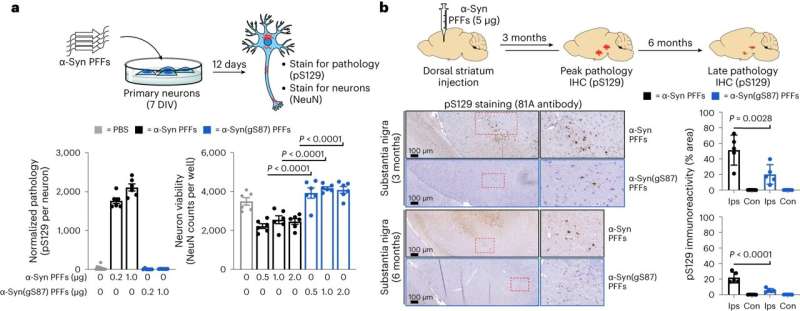This article has been reviewed according to Science X's editorial process and policies. Editors have highlighted the following attributes while ensuring the content's credibility:
fact-checked
trusted source
proofread
Protein modifications found to be key influencers in neurodegenerative diseases

Neurodegenerative diseases, such as Alzheimer's and Parkinson's, present a significant health challenge, affecting over 50 million people globally. One common feature of these diseases is the accumulation of misfolded protein aggregates in the brain, known as amyloid fibrils, which disrupt normal cell function and eventually lead to cell death.
In a new study, scientists led by Hilal Lashuel at EPFL and Matthew R. Pratt at USC have made a significant advancement in understanding how post-translational modifications (PTMs)—changes that happen to proteins after they are synthesized in the cell—can influence the formation and pathogenicity of these amyloid fibrils.
The researchers studied the protein alpha-synuclein, which is linked to the formation of amyloid fibrils in Parkinson's disease. The researchers looked at a specific modification that the protein undergoes, technically known as "O-linked β-N-acetylglucosamine" or O-GlcNAc for short.
O-GlcNAc is a kind of modification that adds a single sugar molecule, to specific serine or threonine residues in the protein, thereby altering its function and properties. It has been linked to several biological processes, including protein aggregation and neurodegeneration. This modification, particularly on alpha-synuclein, has been shown to slow down amyloid aggregation and potentially protect neurons.
Previous studies by Pratt's and Lashuel's groups have suggested that increasing the O-GlcNAc modification could have therapeutic potential in early stages of neurodegenerative disease, altering the properties of protein aggregates to prevent their seeding and spread in the brain, potentially slowing disease progression.
Building on this, the team employed innovative chemical methods to produce modified alpha-synuclein fibrils, working with the group of Virginia Lee at the University of Pennsylvania. They also used cell and animal models to study how O-GlcNAc affects the pathogenic properties of alpha-synuclein, and worked with the group of Lorena Saelices at UT Southwestern Medical Center to observe the modified fibrils with cryo-electron microscopy.
The study showed that the increased modification produces fibrils with distinct structural and biochemical features. These fibrils result in a strain of amyloid fibril with a dramatically reduced ability to seed aggregation in neurons and animal models of Parkinson's disease. Interestingly, this strain of fibrils can seed aggregation in vitro, but not in neurons or live mice.
"Our findings show that this environment in the cell plays an important role in determining the pathogenicity of this protein," says Anne-Laure Mahul, one of the study's co-first authors.
The study suggests that modifications like O-GlcNAc could play a role in modulating the pathogenicity of alpha-synuclein, which opens up new avenues for research and potential treatments. For instance, targeting the O-GlcNAc modification process could lead to therapies that alter the progression of Parkinson's by influencing the ability of pathogenic alpha-synuclein species to spread to different brain regions.
In a related Research Briefing by Nature, the authors write, "[O]ur work on the O- GlcNac modification of [alpha-synuclein] sheds new light on the molecular determinants of the pathobiology of amyloid fibrils and provides new therapeutic targets for preventing amyloid growth and spreading at both early and late stages of disease development and progression."
The research is published in the journal Nature Chemical Biology.
More information: Aaron T. Balana et al, O-GlcNAc forces an α-synuclein amyloid strain with notably diminished seeding and pathology, Nature Chemical Biology (2024). DOI: 10.1038/s41589-024-01551-2





















